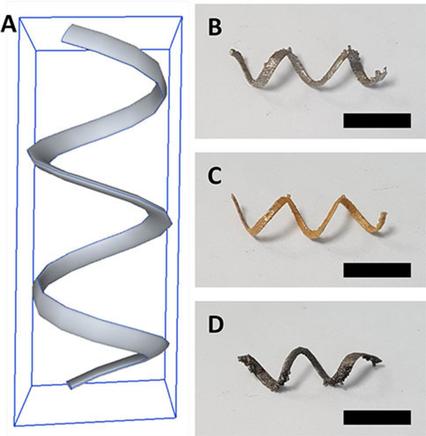当前位置:
X-MOL 学术
›
Electroanalysis
›
论文详情
Our official English website, www.x-mol.net, welcomes your
feedback! (Note: you will need to create a separate account there.)
3D-Printed Metal Electrodes for Heavy Metals Detection by Anodic Stripping Voltammetry
Electroanalysis ( IF 2.7 ) Pub Date : 2017-08-02 , DOI: 10.1002/elan.201700388 Ke Yau Lee 1 , Adriano Ambrosi 1 , Martin Pumera 1
Electroanalysis ( IF 2.7 ) Pub Date : 2017-08-02 , DOI: 10.1002/elan.201700388 Ke Yau Lee 1 , Adriano Ambrosi 1 , Martin Pumera 1
Affiliation

|
Heavy metals, being one of the most toxic and hazardous pollutants in natural water, are of great public health concern. Much effort is still being devoted to the optimization of the electroanalytical methods and devices, particularly for the development of novel electrode materials in order to enhance selectivity and sensitivity for the analysis of heavy metals. The ability of 3D-printing to fabricate objects with unique structures and functions enables infinite possibilities for the creation of custom-made electrochemical devices. Here, stainless steel 3D-printed electrodes (3D-steel) have been tested for individual and simultaneous square wave anodic stripping analysis of Pb and Cd in aqueous solution. Electrodeposition methods have also been employed to modify the steel electrode surface by coating with a thin gold film (3D−Au) or a bismuth film (3D−Bi) to enhance the analytical performance. All 3D-printed electrodes (3D-steel, 3D−Au and 3D−Bi) have been tested against a conventionally employed glassy carbon electrode (GC) for comparison. The surface modified electrodes (3D−Au and 3D−Bi) outperformed the GC electrode demonstrating higher sensitivity over the studied concentration ranges of 50–300 and 50–500 ppb for Pb and Cd, respectively. Owing to the bismuth property of binary alloys formation with heavy metals, 3D−Bi electrode displayed well-defined, reproducible signals with relatively low detection limits of 3.53 and 9.35 ppb for Pb and Cd, respectively. The voltammetric behaviour of 3D−Bi electrode in simultaneous detection of Pb and Cd, as well as in individual detection of Pb in tap water was also monitored. Overall, 3D-printed electrodes exhibited promising qualities for further investigation on a more customizable electrode design.
中文翻译:

用于通过阳极溶出伏安法检测重金属的 3D 打印金属电极
重金属是天然水体中毒性最强、危害最大的污染物之一,受到公众健康的极大关注。仍在致力于优化电分析方法和设备,特别是开发新型电极材料,以提高重金属分析的选择性和灵敏度。3D 打印制造具有独特结构和功能的物体的能力为创建定制电化学设备提供了无限可能。在这里,不锈钢 3D 打印电极(3D 钢)已被测试用于水溶液中 Pb 和 Cd 的单独和同时方波阳极剥离分析。还采用电沉积方法通过涂覆薄金膜 (3D-Au) 或铋膜 (3D-Bi) 来改进钢电极表面,以提高分析性能。所有 3D 打印电极(3D 钢、3D-Au 和 3D-Bi)均已与传统使用的玻璃碳电极 (GC) 进行对比测试。表面改性电极(3D-Au 和 3D-Bi)优于 GC 电极,在 Pb 和 Cd 的研究浓度范围分别为 50-300 和 50-500 ppb 时表现出更高的灵敏度。由于与重金属形成二元合金的铋特性,3D-Bi 电极显示出明确的、可重现的信号,对 Pb 和 Cd 的检测限分别为 3.53 和 9.35 ppb。3D−Bi 电极同时检测 Pb 和 Cd 的伏安行为,此外,还监测了自来水中铅的个体检测。总体而言,3D 打印电极表现出有希望的品质,可用于进一步研究更可定制的电极设计。
更新日期:2017-08-02
中文翻译:

用于通过阳极溶出伏安法检测重金属的 3D 打印金属电极
重金属是天然水体中毒性最强、危害最大的污染物之一,受到公众健康的极大关注。仍在致力于优化电分析方法和设备,特别是开发新型电极材料,以提高重金属分析的选择性和灵敏度。3D 打印制造具有独特结构和功能的物体的能力为创建定制电化学设备提供了无限可能。在这里,不锈钢 3D 打印电极(3D 钢)已被测试用于水溶液中 Pb 和 Cd 的单独和同时方波阳极剥离分析。还采用电沉积方法通过涂覆薄金膜 (3D-Au) 或铋膜 (3D-Bi) 来改进钢电极表面,以提高分析性能。所有 3D 打印电极(3D 钢、3D-Au 和 3D-Bi)均已与传统使用的玻璃碳电极 (GC) 进行对比测试。表面改性电极(3D-Au 和 3D-Bi)优于 GC 电极,在 Pb 和 Cd 的研究浓度范围分别为 50-300 和 50-500 ppb 时表现出更高的灵敏度。由于与重金属形成二元合金的铋特性,3D-Bi 电极显示出明确的、可重现的信号,对 Pb 和 Cd 的检测限分别为 3.53 和 9.35 ppb。3D−Bi 电极同时检测 Pb 和 Cd 的伏安行为,此外,还监测了自来水中铅的个体检测。总体而言,3D 打印电极表现出有希望的品质,可用于进一步研究更可定制的电极设计。











































 京公网安备 11010802027423号
京公网安备 11010802027423号